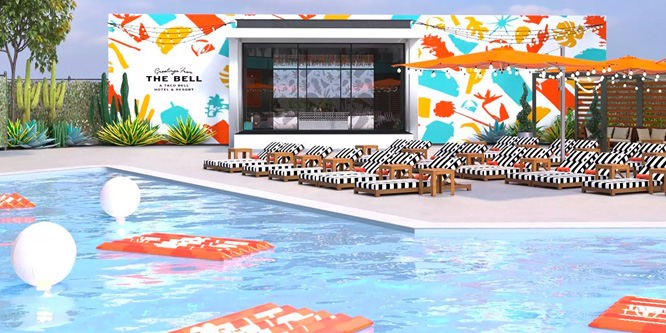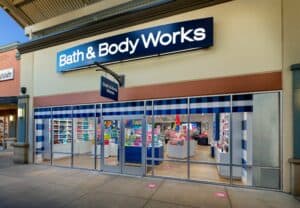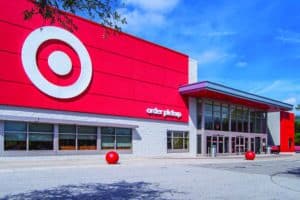
Photo: Taco Bell
October 7, 2019
What if stores innovated like restaurants?
WayfinD staff
Through a special arrangement, what follows is an excerpt of an article from WayfinD, a quarterly e-magazine filled with insights, trends and predictions from the retail and foodservice experts at WD Partners.
When looking at the top of the list on Nation’s Restaurant News’ Top 200, it’s clear the leading restaurants are constantly innovating.
A few examples:
- #9 – Domino’s: With delivery confounding restaurants everywhere, Domino’s is more about logistics and technology than pizza. Customers can track their pizza every step of the way on their phones. Hello, instant gratification! Using their own drivers for years, they continue to develop more efficient delivery methods. The pizza? The company actually admitted it sucked a few years ago and upgraded that as well.
- #6: Burger King: Someone had to do it. Burger King was the first brand to offer a legitimately tasty plant-based burger on a national basis to gain first dibs with vegetarians and flexitarians.
- #5 – Taco Bell: A hotel fully branded as Taco Bell? Taco Bell clothing and Taco Bell Cantinas selling alcoholic beverages? Much like fellow Yum! Brands innovator KFC, Taco Bell is creating a lifestyle brand for its fervent followers and no innovative idea is too weird to be considered.
What can stores learn from these restaurant innovators? Understanding customers will guide innovation.
Let’s look at struggling retailers as comparative examples:
- J.C. Penney: What if J.C. Penney at some point came out and said, “We talked to our customers, and our stores suck. We’re studying what’s wrong and we’re going to revamp the entire store.” Incremental changes to pricing, product and stores haven’t made an impact. Incremental does not work in today’s retail world.
- Victoria’s Secret: Burger King isn’t changing its entire menu to be vegetarian. Why can’t Victoria’s Secret add some more inclusive products?
- Toys “R” Us: A toy store where kids can freely play? A showroom store makes perfect sense for toys. We all wanted to be Toys “R” Us kids. Why didn’t TRU take advantage of that nostalgia and create a Taco Bell style lifestyle brand before it was too late?
Come on retailers, listen to your customers and understand the innovative ideas they are asking you for.
Discussion Questions
DISCUSSION QUESTIONS: What can retailers learn about innovation from restaurants? Are retailers generally more hesitant to try new things versus restaurants, and is there a logical reason why?
Poll
BrainTrust
Lisa Goller
B2B Content Strategist
Nikki Baird
VP of Strategy, Aptos
Recent Discussions








Taco Bell’s four-day PR gimmick of a branded hotel is a far cry from Toys “R” Us. Most any independent toy store has plenty of places for kids to play. Ask J.C. Penney customers what they want and they’d probably say more discounts. The customer doesn’t always know what is best. The winners in retail right now like Lululemon understand who their customer is and what is important to them, and add onto that experience. I would suggest innovation comes from a laser focus on delivering to customers, not PR.
Restaurants were late to invest in customer relationships and loyalty and worse than that, they adopted a commoditized approach. Much like retailers. The difference is that leading brands in the restaurant industry figured out sooner than retailers that innovation was required given the rising consumer expectations that Amazon has set and that most retailers have snoozed on.
While it surprises even me to have to write that, restaurants are hungrier (pun intended), apparently, than retailers. Or they are smarter. Or more paranoid. Regardless, there is a lot of excitement happening in that category.
I do think that successful retailers are innovative. Supermarkets, for example, remodel stores to meet customer demand. Didn’t the Nike store add basketball hoops to attract more shoppers? Granted many retailers do little or nothing and they seem to disappear or are acquired. I guess I do not completely agree with the premise that restaurants are more innovative than retailers!
Agreed Frank – it’s not exactly fair to compare some of the most innovative and socially tactical QSR brands against retailers that have had their struggles well documented. Restaurants also often have the advantage of their customers purchasing from them at a much higher frequency than retailers (could you imaging going to J.C. Penney as often as your favorite QSR?) – and this frequency of interaction creates a reason for a deeper dialogue between customer and brand. Many retailers who we might score high in successfully innovating (Amazon, Kohl’s, Target) also share that advantage.
Restaurants show retailers the power of humbly listening and adapting to evolving consumer tastes. Innovation helps companies spice things up, which can encourage consumers to keep coming back – and visit more often.
Domino’s reminds retailers to lead with their strengths (e.g. consumer-friendly, real-time visibility into the logistics process) to stand out amid intense competition.
In addition, Burger King shows that retailers don’t need to overhaul their business strategy if a simple assortment change can differentiate their offerings by reflecting emerging consumer trends.
Yes! “…assortment change…” THAT is listening to the customer!
I really don’t think restaurants are any more innovative than retailers. You called it out – “leading.” Leading restaurant chains are innovating. So are “leading” retailers. Walmart, Best Buy or Kohl’s are doing things that are just as customer-centric or operationally beneficial as any of the programs profiled in the above article. Companies, regardless of segment, that have the right culture to innovate are the ones that will continue to win. Unfortunately, too many retailers and restaurant chains don’t have that culture.
Sometimes technology can be oversold as a magic solution to retail problems. Domino’s is more about logistics and technology than pizza? Not in a million years. I’m going to order from Domino’s rather than another current pizza favorite just so I can gaze at my phone for the next 27 minutes? First and most important (with no close second place contenders) is that Domino’s has to have the best pizza. Period. And I can track the delivery if I am so inclined? Fine. Most important is the best pizza, shirt, sweater, jacket, gizmo, widget. Then help me track the delivery.
Restaurants have been leading the way for some time. They have been leaders in BOPIS where customers order, customize said order, pay online and avoid the checkout process in the restaurant. This change in process has forced restaurants to rethink the technology necessary to complete this type of transaction with side benefits of reducing shrink by eliminating in-store cash and credit handling as well as sweethearting. Having gained hard-savings benefits leveraging technology and process changes with BOPIS, restaurants are now more open to innovation such as focusing on auto-identification of customers in the drive-thru to reduce the time spent in the queue and, leveraging things like IoT.
Traditional retailers need an ROI win before they will take a chance. They are too risk averse and focused on the hard-savings cost benefit. It may have something to do with the difference in reporting organization structures within the segments that drives this risk aversion. Where do IT and Marketing report? Are they in sync or in competition for IT spend? I’ve worked extensively in both segments and witnessed this first hand……a great callout!
“Listen to your customers, they’re smarter than you.” Rich and I said that in our first presentation and we still say it today. Because your customers ARE smarter than you. They know what they like and they know where to go to get it if they can’t get it from you. Seems simple, doesn’t it?
To use the article’s examples, Domino’s comes up with so many new things it’s hard to keep track – but they keep customers in the loop about what they are doing. Too many retailers send an email and think that’s good enough; it’s not. Burger King has never been afraid to try something new; it’s always been out there. In a good way. Taco Bell just has fun and invites customers to play along. (You can have complete conversations, on a variety of topics, just using Taco Bell’s sauce packets.) In contrast, J.C. Penney quietly does more of the same, Victoria’s Secret needs an overhaul, and Toys “R” Us had other issues to deal with that went beyond what happened on the sales floor.
So yes, I think retailers can learn from restaurateurs – too many of the stores we all shop in today look much the same as they did 10 years ago.
While restaurants definitely do innovate, the challenges that retailers face are different which could explain the speed of innovation.
Retailers have to:
There are definitely lessons to learn about using store layouts to encourage conversion of purchase, speedy checkout, delivery etc. The assortment itself is a challenge.
Purpose-led innovations that solve a real customer experience challenges are what will resonate and potentially lead to sales, margin and EBITA improvements. These restaurant examples are quite gimmicky in nature, and will not have long-lasting customer experience impacts. Rather than following the restaurants companies should emulate fellow retailers and DTC companies that are getting it right.
It’s all about lifestyle, health, and wellness. Companies such as Patagonia, Lululemon, and Nike are leveraging technological innovations to enhance the customer experience, build stronger bonds with the communities they serve and help to enhance people’s lives rather than just focusing on selling products.
I’m also not sure the examples in this article are all that innovative. “Domino’s is more about logistics and technology than pizza?” Great if people like to munch on software systems, but I think it doesn’t matter how efficiently you get a pizza to a house if the end product isn’t better than alternatives. “Burger King was the first brand to offer a legitimately tasty plant-based burger on a national basis to gain first dibs with vegetarians and flexitarians?” Really? Most of the reviews I’ve read say it does in fact taste just like a Whopper — which is the problem. And as for the Taco Bell hotel, I never did get that one. All I can picture is a hotel room where your clothes pick up a distinctively unpleasant smell after you take them out of the closet. Admittedly, the author makes good points about J.C. Penney and Victoria’s Secret … but a Taco Bell-style Toys “R” Us is a bridge too far — at least for a Monday.
It is easy to dismiss the Taco Bell hotel as a PR stunt and leave it at that. But that is missing so much of the point. Taco Bell could have spent the money they spent decorating that hotel on advertising and saturated every digital and media touchpoint, and it would not have yielded anything close to the buzz, the free press – every travel blogger in the world was obligated to report first hand – and the boost to the Bell’s reputation that they’re cool and fun and not afraid to try things, all a result of simply buying “hot sauce throw pillows” (which they can now probably auction off on eBay).
Consumers’ hearts and minds may be won by high quality service or low, low prices. But you never get an at-bat if you can’t break into the bubbles of their lives. Advertising isn’t enough to do it, even digital advertising. It has to be something that has personality, that shows that you’re more than just a corporate straitjacket, that you know how to connect with consumers long before they walk into your store. THAT is what retail is missing.
As to why: I’ve long held a theory that because retailers operate so publicly (in no other industry is your strategy literally on display) they tend to be overly protective of everything else. You can almost never get a retailer to talk about their technology investment successes (“but it’s our secret sauce”) and, likewise, their social media is locked down tight – safe, bland, not offensive to anyone. And also not engaging in any way.
This discussion leads me to suggest what I’ve been saying for literally decades: Don’t be too proud to look outside your industry for best practices and innovation. Retailers should leverage some things that restaurants are doing, HOWEVER, restaurants could definitely learn a thing or two from high-volume retailers about swift checkout/payment processes. Some already are, in airports, for instance, where you can pay at your table via table-mounted screens, QR codes, etc.
Also retailer could learn a bunch from the hospitality and airline industries about loyalty, right? Consumers stay with single air and hotel brands whenever possible, yet there is very little loyalty among retail brands.
Here’s the point that Georganne and I preach in every presentation: Evert year, in our ultra competitive markets, for every retailer, the world changes by 10 percent. Reinvention of the retail industry. Therefore, if a retailer doesn’t change each year by at least 10%, in three years they are at a minimum, 30% behind all competitive ventures, coming dangerously close to obsolete. And that catch-up time is dangerous territory. Today, the in-store experience has to exceed expectations with every visit. Tough? Yes! Necessary? As much as breathing air.
The depreciation schedule for restaurants is less than the five year schedule most merchants work on. Based on tax law, it’s not in the ball park for most merchants.